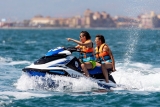
Taking on a DIY project requires not only time and skill but also knowing how to source the most suitable materials for your creation. If your new "project" involves making your own kitesurfing board, it's best to thoroughly research how and where to acquire all the components that will help you ride the waves.
Building a kitesurfing board mainly requires obtaining the right materials, but also having the proper tools along with the skill and care to avoid a botched job, so you can practise your favourite watersport with full pride.
The first step is gathering all materials to begin construction as efficiently as possible, without having to gradually acquire tools that would only slow down your progress. Here's a list of necessary components to build your own kitesurfing board:
- Beech wood laminate for the "Pads area".
- 20mm thick high-density foamed PVC sheets (Divicell model).
- 160x41 cm sheet.
- 122x79 cm sheet.
- Pair of B3 Lux Kite Straps.
- 8x160 cm PVC edges (6 units - enough for 2 boards).
- Hollow fibreglass tube for fin screws.
- Nylon inserts for strap and handle screws (each unit yields 2 inserts).
- 49g/m² fibreglass veil for a "fine" finish (400x64cm).
- 45° Twill A fibreglass weave (adapts perfectly to curves) 205g/m² (200x120cm).

Purchasing all materials typically costs around €120-130 on average. Buying everything together is most advisable, as acquiring items individually can sometimes work out more expensive. That said, the wood sheets and straps tend to be the priciest components.
For kiteboard construction, it's best to have a dedicated workspace where you can always work and keep all components within reach for comfortable assembly. If kitesurfing itself already delivers an adrenaline rush and new thrills every time you ride, imagine doing it with equipment you've built yourself. It'll be an unparalleled feeling!
Material technology is particularly important when selecting components, as modern materials are increasingly lightweight yet durable - like polyurethane laminates (despite varying densities and hardness levels) or fibre sheets that protect the board's high-impact areas from heel strikes after kitesurfing jumps. These materials, surprisingly durable despite their light weight, are virtually unbreakable - making fibreglass, carbon fibre and/or Kevlar essential for board construction.
The most challenging part of building your kitesurfing board is sourcing the materials. Once you have them, you'll be so excited throughout the process that you'll feel like a child just imagining how you'll fly across waves like never before on equipment you crafted yourself.
You can always seek advice from professionals and kitesurfing schools available along all Spanish coastlines. Here you'll find some of the best options to unleash your kitesurfing passion, get second opinions, or simply rent equipment to identify your preferred board model for your new DIY kitesurfing board.












